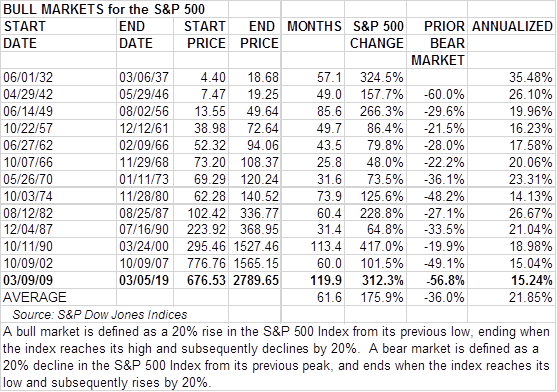The bull market is almost 10 – here are some facts and figures
Barring a catastrophic event before the weekend, the S&P 500’s current bull market will turn 10 years old on Saturday, March 9.
Since 2009, the S&P 500 (^GSPC) has returned an annualized 17.68% total return and gained $17.5 trillion on a stock basis, according to data from Howard Silverblatt at S&P Dow Jones Indices.
That’s a long way from March 9, 2009, when the S&P 500 closed at 676.53. On that day, commentators were still analyzing President Barack Obama’s $787 billion stimulus bill and word was that Bernie Madoff was going to plead guilty to running a massive multi-billion-dollar Ponzi scheme. Shares of Citigroup, Bank of America and Wells Fargo were all trading below $10 as investors punished them for making betting too much on a housing market that crashed.
As of market close Wednesday, the S&P 500 has since surged about 310% to 2,771.45, which extends a nearly 120-month bull market. The next longest bull market was the 1990 to 2000 rally that lasted 113 months, during which the S&P 500 grew by 417%.

Winners and Losers
Silverblatt wrote March 6 that consumer discretionary stocks have done the best during this current bull market, with information technology in second. To little surprise, the top contributors to the S&P 500’s growth during this period were tech companies. Apple (AAPL) and Microsoft (MSFT) were the two largest contributors to the S&P 500’s gains by notching total annualized returns of 32.65% and 25.18%, respectively.
JPMorgan Chase (JPM) and General Electric (GE) were the third and fourth largest contributors and returned 23.42% and 6.57% in total annualized returns, respectively.
“Few would have guessed fourth place - General Electric, which was up in price, with dividends adding the bulk of its impact to the index,” Silverblatt wrote.
Stock pickers could have even more attractive stocks in the S&P 500 if they bought equities like Obama suggested in early March of 2009. Over the last ten years, Ulta Beauty (ULTA) has yielded annualized total return of 53.79% and medical implant device manufacturer Abiomed (ABMD) has returned 51.90%. The third highest gainer in the last ten years: an entertainment company called Netflix (NFLX) which has booked an annualized total return of 51.75%.
Only nine companies failed to return positive annualized total returns. The worst performer: CenturyLink (CTL), which has had an annualized total return of -6.56% over the last ten years.
Brian Cheung is a reporter covering the banking industry and the intersection of finance and policy for Yahoo Finance. You can follow him on Twitter @bcheungz.
Read more:
NY Fed's Williams on the outlook for monetary policy: 'It depends'
Larry Summers: Modern Monetary Theory is 'grotesque'
The Fed may be suffering from a 'credibility' issue with its inflation target
Will we get to 3% GDP growth this year? Economists say no.
Congress may have accidentally freed nearly all banks from the Volcker Rule

